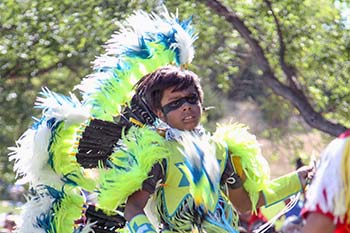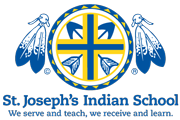Home » Native American Culture » Powwow » Powwow Dance Styles for Men
Lakota (Sioux) Powwow Dance Styles
Long ago, the Lakota (Sioux) people would dance to celebrate the coming of spring and their relationship with the Earth. Dance was a form of prayer thanking Wakȟáŋ Tȟáŋka — Great Spirit — for another year of life.
Every powwow is different, but most gatherings are considered either a traditional wačhípi — dance — or the more contemporary powwow contest.
Traditional powwows are held to honor groups or individuals. These gatherings are more ceremonial in nature and participating dancers are gifted a minimal amount of money for their attendance. Contest powwows, however, are typically larger competitive events that provide prize money for dancers.
St. Joseph’s powwow, “Gathering of the Wakȟáŋheža” is a contest-oriented event. Our goal is to celebrate each other, especially the wakȟáŋheža — little beings!
There are four main types of powwow dances at St. Joseph’s Indian School’s annual powwow. Each dance is unique and beautiful in its own way.
Let’s walk through powwow dances performed by males.

Traditional Dance
The men’s Traditional Dance provides an image of past warriors who would return from hunting or battle and tell their story through dance.
In the past, a traditional dancer was typically an elder who had earned the right to carry eagle feathers. Today, however, traditional dancers are of all ages. The feathers worn by the dancers are arranged in a single bustle and worn on their lower back. The bustles and other regalia are symbolic of a dancer’s relationship with nature and connection to the Great Spirit.
Long ago, veteran warriors carried a shield and lance or coup stick to indicate their status.
At today’s powwows, elder traditional dancers wear a breastplate and regalia adorned with traditional quillwork or beadwork. The dancers’ regalia is made from natural material and is not as brightly colored as other dancers. Some regalia takes years to complete; some is handed down through generations of a family and may be over 100 years old.
Dancers also carry a feather fan and, on occasion, a horse effigy dance stick.
Songs for this dance are sung at a slower pace as the words reflect the honor traditional dancers feel when asked to protect the people.

Fancy Dance
This contemporary dance style is FAST, exciting and full of color!
The Fancy Dance was introduced during the reservation era when tribes from the southern plains conducted large gatherings for spectators who wanted to witness a war dance. After mázaska — money — was introduced to the dance circle, the popularity of the gatherings increased.
Dancers made their outfits as colorful and brilliant as possible for entertainment purposes. Young dancers wear a head roach with two rocker feathers, two bustles on their back and bands on their arms.
The dancers carry twirling spinners as they hop, jump, skip and perform acrobatic movements throughout the dance.
Today, fancy dancers continue to offer spectators a showcase of fancy footsteps, quick acrobatics and stamina. The best dancers are able to keep in time to the extremely fast drumbeat and stop on the last beat of the drum.

Grass Dance
The Grass Dance, or Omaha Dance, was originally a ceremonial dance to celebrate the people’s relationship with Mother Earth. The regalia is unique because it has almost no feathers; it consists of a shirt and trousers with colorful fringe attached.
Long ago, grass dancers wore tufts of prairie grass in their belts as they flattened the tall prairie grass where the tipi lodges were erected or where a powwow would be taking place.
Today, the Grass Dance is very popular among younger dancers. The dancers try to emulate the movement of the grass blowing in the breezes of the Great Plains as they sway from side to side.
Good grass dancers are able to keep in time with the drum, flow with the breeze and show balance in their dance routine.
We hope you can join us for our Annual Powwow Celebration and see these dances in person! For more information on our powwow, please visit stjo.org/powwow.
“I dance to make my grandpa proud — he taught me how.”
